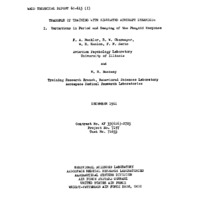-
Title
-
Transfer Of Training With Simulated Aircraft Dynamics: I. Variations In Period And Damping Of The Phugoid Response
-
Date
-
1961
-
Index Abstract
-
Contrails only
-
Photo Quality
-
Not Needed
-
Report Number
-
WADD TR 60-615 Part (I)
-
Creator
-
Muckler, F. A.
-
Hanlon, W. H.
-
Serio, F. P.
-
Rockway, M. R.
-
Obermayer, R. W.
-
Corporate Author
-
Training Research Branch, Behavioral Sciences Laboratory Aerospace Medical Research Laboratories
-
Aviation Psychology Laboratory University Of Illinois
-
Laboratory
-
Behavioral Sciences Laboratory
-
Extent
-
50
-
Identifier
-
AD0278627
-
AD0278627
-
Access Rights
-
OTS
-
Distribution Classification
-
1
-
Contract
-
AF 33(616)-2725
-
DoD Project
-
7197
-
DoD Task
-
71635
-
DTIC Record Exists
-
No
-
Distribution Change Authority Correspondence
-
None
-
Report Availability
-
Full text available
-
Date Issued
-
1961-12
-
Abstract
-
This report is the first in a series dealing with transfer of training skill as a function of variations in simulated aircraft longitudinal dynamics. The research is pertinent to the question of how accurately the aerospacecraft simulator must represent the dynamic flight responses of the aerospacecraft in order to assure optimum transfer of training.
Subjects performed one-dimensional tracking of a slow, low-amplitude sine-wave input. The control dynamics of major concern were long-period oscillatory transients (the phugoid response). Independent variations were made in the period and damping of the phugoid response. Also, pilot and non-pilot performance was compared.
During the training trials, tracking performance was poorer the longer the period of the phugoid response. For the slowest period (71 seconds), tracking performance was often below that which could have been obtained with no movement of the operator's control. Wide variations in damping had no differential affect on tracking performance. Pilots and non-pilots did not differ in tracking performance during training trials.
Performance on the transfer trials was considerably influenced by the relationship between the period of the phugoid response in the training task and the period of the phugoid response in the transfer task. When the period of the phugoid response during training was shorter or longer than that for the transfer task, performance was inferior to when it was the same. Variations in damping did not differentially influence transfer of training.
-
Provenance
-
IIT
-
Type
-
report
-
Publisher
-
Wright-Patterson Air Force Base, OH : Behavioral Sciences Laboratory, Aerospace Medical Research Laboratories, Aeronautical Systems Division, Air Force Systems Command, United States Air Force
-
Distribution Conflict
-
No
-
Cover Price
-
$1.50
-
Subject
-
Aircraft
-
Flight Simulators
-
Measurement
-
Military Training
-
Simulation
-
Format
-
1 online resource
 WADDTR60-615part01.pdf
WADDTR60-615part01.pdf